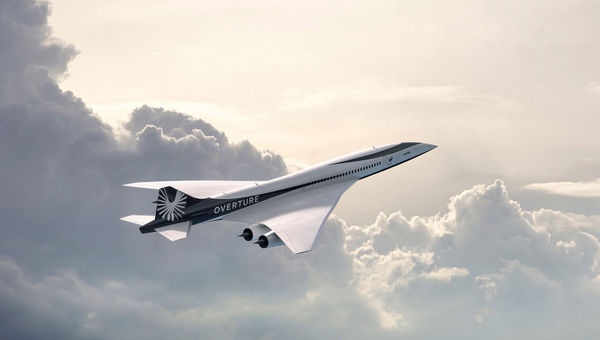Boom Supersonic has gone, well, supersonic.
The start-up civil aircraft developer took its XB-1 prototype demonstrator above the speed of sound on three occasions during a test flight over the California desert on Tuesday morning.
"It's time to go big," Boom CEO Blake Scholl said moments after the craft landed at the Mojave Air & Space Port. "It's time to bring supersonic flight back. It's time to bring it back for all of us. It's time to bring it back in a mainstream way."
XB-1 makes history
The flight was the first supersonic run for an American-designed civil aircraft. The XB-1 is one-third the size of the planned 64- to 80-passenger Overture airliner that Boom intends to begin test flying before the end of the decade. Boom will make one more supersonic test flight with the XB-1 before retiring the craft and turning its full attention to Overture, Scholl said.

A rendering of Boom's Overture supersonic aircraft design. Photo Credit: Courtesy of Boom Supersonic
The XB-1 is powered by General Electric J85-15 engines developed several decades ago. The craft's fuselage and other components are also made from existing subsonic airliner technology, Scholl said. Boom has used the XB-1 program to validate various design features, the learnings from which will be used as Overture development moves forward.
Scholl said Boom is 18 months away from building its first Overture at its factory in Greensboro, N.C.
Plans for the Overture
The company's biggest challenge, however, might be development of a modern, efficient, civil supersonic engine. Boom is developing the engine, which it calls Symphony, itself, having failed to secure the participation of major engine makers, including GE, Rolls-Royce or Pratt & Whitney. Boom intends to fly Overture at 1,300 mph, about twice the speed of today's subsonic commercial jets.
Scholl said Tuesday that the first iteration of the Symphony engine will be operational by the end of the year. Boom has previously said that it expects to build and test multiple iterations before certifying the final engine.
Some aerospace observers remain skeptical.
"This market is all about engines, and right now they're flying a prototype using half-century old engines," Richard Aboulafia, managing director of the aerospace consulting firm AeroDynamic Advisory, said in an email Tuesday. "There's no coherent plans to create a new engine. So, this looks like a fun exercise in aircraft model building."
Scholl said that's it's up to Boom to eventually prove its critics wrong, and he acknowledged that many challenges must be overcome before the Overture can bring back commercial supersonic flight.
"Overture is very much harder than what we did today," he said. "It will not be a straightforward path."